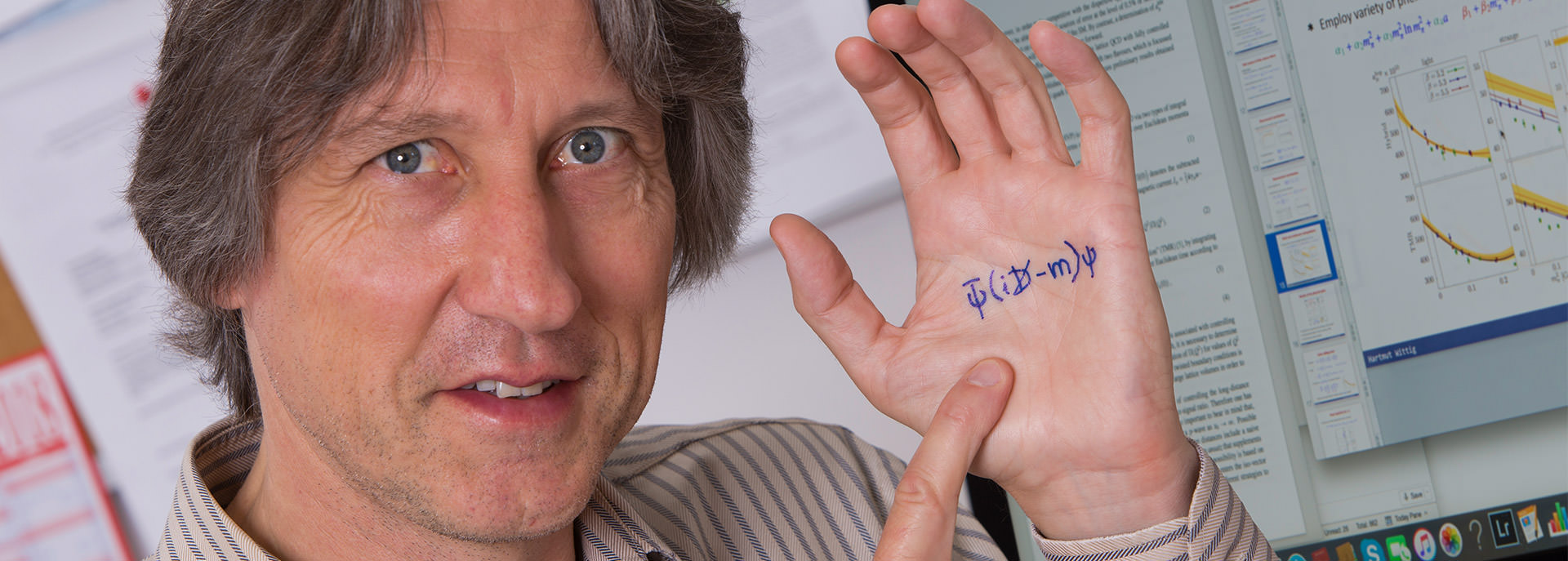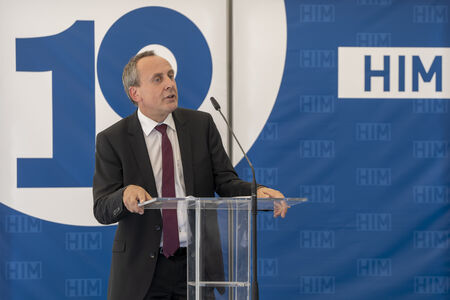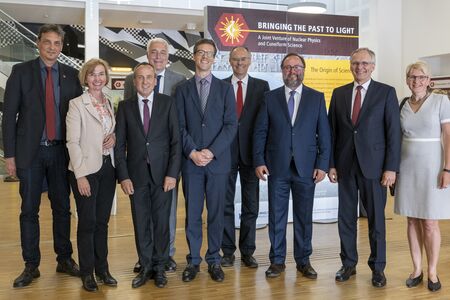The Helmholtz Institute Mainz (HIM) celebrates its tenth anniversary. With its remarkable research achievements in the fields of physics and chemistry, HIM has become an international research center of scientific excellence. At the heart of the institute's work is the FAIR accelerator complex, currently being built at GSI in Darmstadt.
"Our hard work over the institute's first ten years has created a lasting basis that will ensure we continue to make outstanding progress in future. We have succeeded in our aims not only of proposing and establishing the first Helmholtz Institute in Germany as a cooperation between GSI Helmholtzzentrum für Schwerionenforschung in Darmstadt and Johannes Gutenberg University Mainz but also of constructing a state-of-the-art research building," said Professor Kurt Aulenbacher, Director of HIM. "It was the appeal of our infrastructure, in particular, that helped to attract a group of leading researchers to come to Mainz. The research program, which was initially both narrowly focused and extremely ambitious, is now being managed by these first researchers and their teams with the fertile results we have seen so far," the HIM Director stated.
The Helmholtz Institute Mainz as a model of success
Professor Paolo Giubellino, Scientific Managing Director of GSI and FAIR, commented on the tenth anniversary of the Helmholtz-Institut Mainz: "HIM is one of the two Helmholtz institutes in which GSI is participating and which strengthen our user community and lead to unique opportunities. The foundation ten years ago was a decisive step with which we placed our already very good cooperation on a solid institutional basis which allows to optimally combine the competences of the Mainz University and GSI to produce world class scientific results. At the same time, this is also an extremely important building block for the excellent research that we can conduct at the international accelerator center FAIR. Such connections bring researchers from all over the world together and enable extremely fruitful collaborations".
In 2009, the Helmholtz Institute Mainz was the first of today nine Helmholtz Association institutes to be founded on the initiative of the German federal government. The intention was to extend the long-standing partnership between GSI in Darmstadt and Mainz University and to promote the university’s profile in this field of research. As is usual for projects of this kind, the HIM is financed by the federal government (90 percent) and the state of Rhineland-Palatinate (10 percent). In addition, JGU makes available its technical infrastructure, scientific and technical staff as well as operating resources. The HIM has a total annual budget of approximately EUR 11 million.
"Helmholtz institutes are a valuable instrument for establishing long-term strategic partnerships between a Helmholtz Center, a university, and, occasionally, other partners," said Professor Otmar D. Wiestler, President of the Helmholtz Association. "They create an excellent basis for close cooperation in a pioneering field of research in which both partners complement each other. This makes them an attractive destination for top researchers from all over the world. Founded in June 2009, the HIM was the first Helmholtz institute in Germany. Ever since, the GSI Helmholtzzentrum network on the Gutenberg Campus in Mainz was making a name for itself as a pioneer in research into the strong interaction."
The Rhineland-Palatinate Minister of Science, Professor Konrad Wolf, also endorses this new model of cooperation between Helmholtz centers and universities: "Thanks to the achievements it has already attained in the field of fundamental physics, the Helmholtz Institute Mainz has become an internationally recognized and prominent facility in the Rhineland-Palatinate research landscape. It has clearly demonstrated just how profitable cooperation between centers of the Helmholtz Association and Johannes Gutenberg University Mainz can be."
"Establishing the Helmholtz Institute on the Gutenberg Campus has provided sustainable enhancement of our groundbreaking research in nuclear physics and nuclear chemistry," emphasized Professor Georg Krausch, President of Johannes Gutenberg University Mainz. "In its role as an influential strategic partner in JGU's Cluster of Excellence on Precision Physics, Fundamental Interactions and Structure of Matter, or PRISMA+, the Helmholtz Institute Mainz is reinforcing our research profile both nationally and internationally."
The Helmholtz Institute Mainz is currently concentrating on the strong interaction, which is the mechanism responsible for the strong nuclear force, one of the four fundamental forces of nature. To shed light on the subject from differing perspectives, the HIM is divided into six research sections. Some of these are dedicated to current and future experiments, chiefly at GSI and FAIR, one of the largest research projects in the world. Other HIM sections are focused on developing new accelerator technologies and working on testing and refining prevailing theories using supercomputers.
The strong force binds quarks and also neutrons and protons, the basic building blocks of the atomic nucleus, together. Researchers at the Helmholtz Institute Mainz are investigating the properties of mesons, i.e., short-lived particles composed of quarks. They are analyzing the structure of the proton and studying the properties of superheavy atomic nuclei. Furthermore, they are hunting for new, hypothetical particles beyond the Standard Model of particle physics and developing new theoretical models and future accelerator technologies.
In 2010, the HIM had a total of 25 personnel, now it counts 135 employees from 16 different nations. These talented individuals and the high-quality infrastructure are the essential resources to generate the anticipated exceptional research results.
Research achievements
Many research projects, often in international alliances, have been successfully completed over the past ten years, while contributions have been made to other projects:
- In 2017, the HIM research section SHE (SuperHeavy Elements) made a breakthrough in the field of chemistry of superheavy elements. They became the first ever research group to generate a compound formed of a superheavy element and carbon. This will enable researchers to study the relationship between the theory of relativity and chemistry.
- Within the ACID (ACcelerator and Integrated Detectors) section, an accelerator research group led by Dr. Winfried Barth managed to increase the efficiency of the technique for accelerating heavy ions significantly with the help of a complex multi-cell CH structure. These structures are required, for example, to generate superheavy elements and investigate their properties. "The significance of this development is difficult to overestimate. As a rule every additional percentage of improvement in efficiency involves a great deal of hard work," stressed Dr. Winfried Barth, head of the ACID section.
- Dr. Miriam Fritsch, a junior HIM scientist, attracted financial support of the Helmholtz Association for the Helmholtz Young Investigators Group PALUMA. She spent six years at HIM in the Precision Spectroscopy of Hadrons with PANDA team.
- The particular structure of the HIM has enabled the establishment of three new professorships, one of them being that of Professor Dmitry Budker, an eminent US-American nuclear physicist, who came to Mainz from the University of California, Berkeley. Since 2014, Budker has headed up the MAM research group, which focuses on high-precision measurement of the fundamental symmetries of nature, one of the four fundamental forces of physics. In 2016, the European Research Council granted EUR 2.5 million in funding by Budker's new project involving the hunt for dark matter and dark energy.
- In 2012, the HIM participated in the successful application to establish the PRISMA Cluster of Excellence at Johannes Gutenberg University Mainz. Today's PRISMA+ now closely cooperates with the HIM, and in 2018 the HIM provided significant support for its successful reapplication.
Modern infrastructure
Researchers in Mainz have a high-tech infrastructure at their disposal. In 2017, for instance, a new Structure, Symmetry, and Stability of Matter and Antimatter institute building of 8,000 square meters was inaugurated, with a state-of-the-art laser and chemistry laboratory and a clean room for assembling and preparing superconducting accelerator modules.
Since 2016, the state government of Rhineland-Palatinate, the federal government, Johannes Gutenberg University Mainz, and the HIM have invested a total of EUR 10.6 million in the new high-performance supercomputer MogonII/HIMsterII, which allows complex computational simulations.
The supercomputer is located in the new computer center in the HIM research building and is operated jointly by the JGU Center for Data Processing and the HIM. Thanks to its total computing power of two petaflops, researchers at the HIM and JGU now have access to the fastest high-performance computer presently installed at a German university.
Related links:
https://www.hi-mainz.de – Helmholtz Institute Mainz (HIM)
Contact:
Professor Dr. Kurt Aulenbacher
Director
Helmholtz Institute Mainz
Staudingerweg 18
55128 Mainz, GERMANY
Tel.: +49 6131 39-29600
e-mail: him(at)uni-mainz.de
Read more:
http://www.uni-mainz.de/presse/aktuell/279_ENG_HTML.php – press release "Structure, Symmetry, and Stability of Matter and Antimatter research building inaugurated" (27 Jan. 2017)





